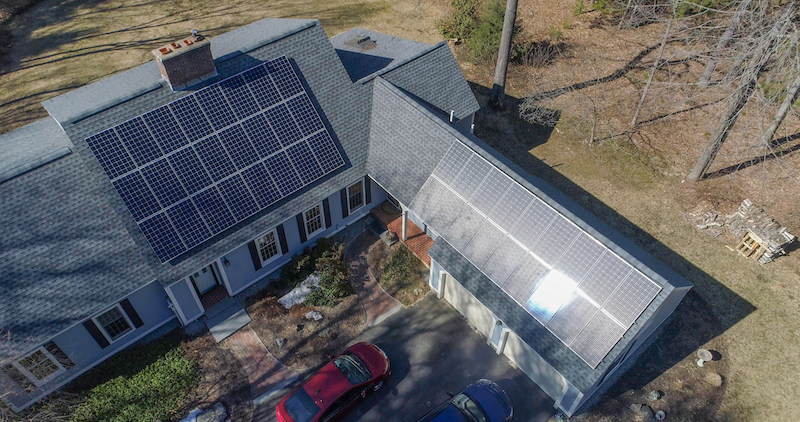
Small-scale solar, like rooftop panels, helped keep our power running when demand spiked during heat waves. Photo: EcoPhotography.
Multiple heat waves hit New England this summer with days above 90 degrees. At least one day hit 102 degrees in Boston—one of the city’s hottest days ever. Up where I live in New Hampshire, it’s been especially hot, too, and not normal summer hot. Many days here were also above 90 degrees, which we never used to get in northern New England. It was so hot that some days I had to keep my two-year-old inside with the AC on for her safety instead of playing outside and enjoying the season. I was thankful we even had the option to do so.
Like me, many people around New England were turning up their fans, cranking up their AC, or finding local cooling centers to deal with the heat. That’s a lot of electricity we’re using, all at once – and electricity we need to keep using when it get this hot outside.
What helped New Englanders deal with this surge in electricity demand? Solar power. All that electricity usage placed a major strain on our regional electric grid. However, solar energy throughout the region (primarily small-scale solar that is customer-owned and on home rooftops) helped keep our power on and even cut electric bills on the hottest days this summer.
Let’s dig into how solar stepped in during these heat waves and why this is a sign New England needs more of it.
Solar Power’s Role in Keeping Us Cool This June
On June 24, the hottest day of the summer this year, electricity use surged to its highest level in over a decade between 6 pm and 7 pm. ISO New England, the entity managing our electricity grid, emphasized how much solar did to meet demand that day. It notes that demand would have actually peaked three hours earlier and been higher if not for small-scale, customer-owned solar power.
By delaying the time of peak demand and significantly reducing it, solar kept our grid reliable and consistent on a day when electricity demand reached an all-time high. Not to mention, according to a recent report, small-scale solar also saved electric customers as much as $19.4 million across the region on this day alone.
Important to note is that several fossil fuel power plants in the region went offline during this heat wave. As a result, the grid operator had to turn to the most expensive and polluting backup power plants to keep the grid operating. Without solar power, the grid operator would have had to rely even more on these rarely used, dirty, and expensive power plants.
Solar Saved Our Summer Multiple Times
Solar power played a crucial role in helping keep our lights and AC running during other heat waves this summer. On the hottest days, solar has regularly been reducing the highest demand and producing around a quarter of our electricity during the sunniest parts of the day. This renewable energy reduced the risk of blackouts and helped families and businesses save on their electric bills.
It has also decreased our dependence on the oldest, most expensive, and most polluting fossil fuel power plants that only operate when electricity demand reaches its highest levels. By using solar power instead of these outdated power plants, we’ve cut bills, climate-damaging emissions, and pollutants that cause asthma and other respiratory diseases.
What Comes Next for Solar Power
The role of solar in keeping our power running on hot days, when our electricity grid nears its breaking point, has been impressive. According to ISO New England, in 2024, small-scale solar generated enough electricity to power about 600,000 homes for a whole year. That’s equivalent to almost the entire population of Vermont.
And there are ways that solar could make an even bigger impact. Pairing solar with more battery storage, for example, spreads out the use of solar energy during the day by storing excess energy. That helps reduce electricity demand when it is less sunny or when the sun has already set. When paired together, batteries and solar help reduce peak demand even further, cutting electric customers’ bills with it. Many of our states have programs offering incentives for combining the power of solar with batteries. Vermont’s Green Mountain Power utility, for example, has already had success in deploying battery storage to reduce grid demand and save customers money.
Since coming into office, the Trump administration has relentlessly attacked renewable energy, like solar, in favor of fossil fuels, even attempting to roll back already awarded funds for the popular “Solar for All” program, which would provide solar benefits to families with low incomes. However, New England’s “Summer of Solar,” where solar energy has reduced blackout risk and saved families and businesses from even more expensive bills, has demonstrated how important it is that we continue to invest in clean, affordable energy upgrades. We must keep momentum on our clean energy transition despite what is happening in Washington.
To ensure that we can keep benefiting from solar (no matter how much you make or where you live), contact your governor to urge them to stay strong on our climate change targets and to adopt policies that encourage increased solar and battery storage development. You can also ask them to fight back against the attempted rollback of Solar for All.



